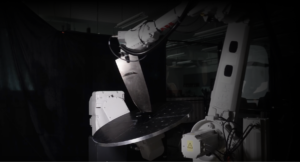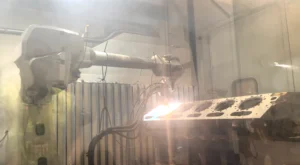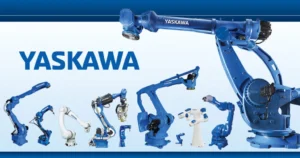table of contents
- Heading 1
- Heading 1
- Heading 1
share this
Manufacturing a pressure relief valve demands meticulous attention to ensure high standards of durability, functionality, and safety. Proper surface treatment is essential for the valve to perform reliably throughout its intended lifespan while minimizing maintenance needs.
Pressure relief valves are vital safety devices, extensively used across a broad range of industries and applications—from hydraulic to chemical processing systems, and from the oil & gas sector to water treatment and supply. Given their widespread application, there is a diverse range of SKUs tailored for specific uses.
Companies engaged in high-mix manufacturing, are continually seeking the most efficient and cost-effective production methods. The complexity increases with the intricate and curved surfaces typical of pressure relief valves. Programming just one SKU can take hours or even days, leading to significant downtime on the shop floor. Scaling this process across 20 SKUs poses even greater challenges.
In this case study, we explore how Augmentus leverages 3D vision and advanced robot motion planning technologies to revolutionize the powder coating process for relief valves. What traditionally takes days can now be accomplished in minutes, significantly enhancing productivity and reducing operational costs. This efficiency revolutionizes high-mix production environments, aligning seamlessly with their diverse demands.
Main Challenges Faced with Traditional Robotic Powder Coating
01 Programming and Path Planning
- Challenge: Programming robots to coat complex curved surfaces requires tedious and time-consuming robot teaching to ensure complete coverage without overspray or missing areas. Each new workpiece or design change can require extensive reprogramming, which is time-consuming and costly.
- Impact: The labor-intensive nature of programming can lead to increased downtime and reduced productivity, particularly for manufacturers dealing with a high variety of SKUs or custom pieces. This also increases the risk of human error during the programming phase, potentially affecting the consistency of the application.
02 Consistency and Uniformity
- Challenge: Curved surfaces and complex geometries can be difficult for robots to access evenly, leading to potential inconsistencies in the coating thickness. Traditional robotic systems may struggle to maintain a uniform distance and angle to the surface, which is crucial for achieving an even coat.
- Impact: Without precise control and adaptability, areas of the workpiece may receive too much or too little powder, leading to runs, sags, or uneven curing, which can compromise the protective qualities and aesthetics of the final product.
How Augmentus’ Advanced Robot Vision and Automated Motion Planning Solve These Challenges
Step 1: Scan

Figure 1: Augmentus’ AutoScan module
Augmentus’ AutoScan module allows planning of the scan type required for accurate coverage of the workpiece. Compatible with external axes (linear or rotary), it also lets you customize scan paths (i.e. length of scans and number of scans) for full coverage and preview the scan path coverage by simulating the scan before the actual scanning process for even better efficiency.

Figure 2: Relief valve undergoing AutoScan
Step 2: Plan
Simply select the areas you wish to coat, and the system will automatically detect the surfaces to be worked on. Process parameters can be effortlessly adjusted and customized according to customer needs.

Figure 3: Augmentus’ AutoPath Software – users can select areas for coating by shading. Brush size options enhance precision.

Figure 4: Automatic waypoint generation – following this, users can adjust process parameters at any waypoint for optimal results.
Key parameters essential for powder coating include:
Step distance:
This refers to the distance the robot moves between application passes. A correct step distance ensures uniform coverage and thickness of the powder coating. If the step distance is too great, it can lead to inadequate coverage and bare spots. Conversely, too small a distance can result in excessive coating, leading to waste and potentially runs or sags in the finish.
Density:
This parameter controls the amount of powder that is applied to the surface per unit area. Proper density settings are vital to achieve the desired coating thickness and quality. Inadequate density can result in poor surface protection, while too much density can cause the coating to be too thick, which not only wastes material but may also affect the drying and curing processes.
Offset:
Offset refers to the distance between the spray gun and the surface being coated. It is critical for achieving optimal adhesion and uniformity of the powder coating. An incorrect offset can lead to uneven coating thickness, poor adhesion, or overspray, which results in material wastage and potential contamination of the workspace.
Speed:
The speed at which the robot moves affects the application rate and the overall quality of the coating. Faster speeds can lead to thinner coatings, which may be insufficient for proper surface coverage. Slower speeds can result in too thick a coating, increasing material costs and potentially affecting the curing process.
Wait:
The wait time is the delay programmed into the robot’s operation to allow for processes such as curing or drying between layers or after a complete pass. Adequate wait times are crucial to ensure that each layer of coating has sufficient time to achieve the necessary chemical and physical properties before the next stage of the process. This affects the durability and finish quality of the coating.
Step 3: Simulate
Simulation plays a crucial role in robotic automation for powder coating applications by facilitating meticulous planning and optimization of the coating process without interrupting the actual production line. It enables customers to visualize and fine-tune robot paths, verify accurate spray angles, distances, and speeds, and anticipate the effects of various settings on the quality of the coating. Additionally, the software can simulate robot movement, complete cycle time calculations, and check for singularity, reachability, and potential collisions.

Figure 5: Simulation of the entire process – ensures all paths are correct before deployment.
This proactive planning approach significantly minimizes the risk of errors and material wastage, reduces downtime due to on-the-fly adjustments and troubleshooting, and accelerates the implementation and transition to full production. By simulating different scenarios and adjusting parameters accordingly, customers can achieve a more efficient, cost-effective, and high-quality coating process.
Step 4: Deploy
After the simulation is completed, the robot script and codes are generated specific to the robot model, end-effector, sensor, and peripherals. The script is transferred seamlessly to the robot controller via FTP or USB.

Figure 6: Script Generation by Augmentus System – Automatically creates scripts based on the selected robot and tools, no coding required.
Step 5: Adapt
Part deviations can arise from various factors, such as mounting errors, manufacturing tolerances, material variations, warpage, and human error, potentially leading to undesirable outputs. Augmentus’ Vision system effectively inspects these parts to ensure the process outcomes meet expectations, focusing on defect detection and coating thickness.
Following this inspection, the Augmentus system automatically generates a robot toolpath (ATG) for areas that do not meet production standards. This inspection and localized adjustment process continues until the desired outcomes are achieved.
Conclusion
With Augmentus’ scan to path solution, users can now plan their paths in minutes instead of weeks, achieving the precision and uniformity essential for powder coating and other applications. This significant reduction in downtime enables high-mix production—typical of many Augmentus customers—to take on more projects and increase output.
Augmentus’ Key Features for Robotic Coating and Spraying:
- 3D scanning for large and complex parts
- Automated robot spray path generation
- Easy-to-use Offline Simulation Interface
- Part-to-part deviation compensation
- Conveyor tracking
- Synchronous motion with external axes
To discover more about Augmentus’ Robotic Spraying System, schedule a complimentary customized demo here.



